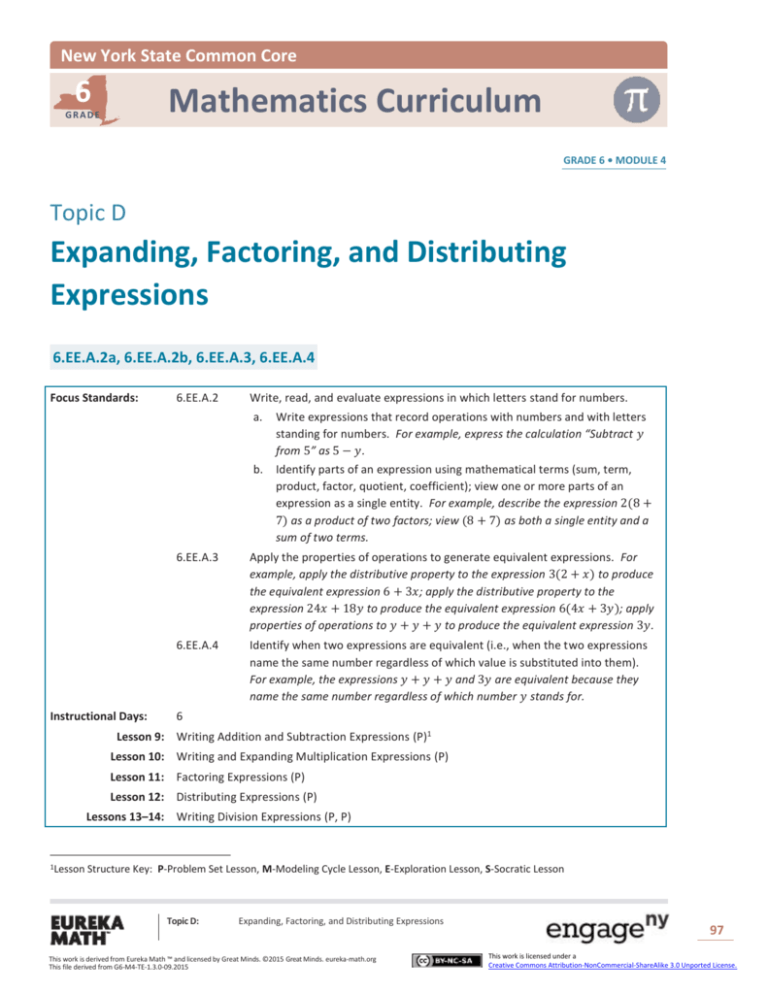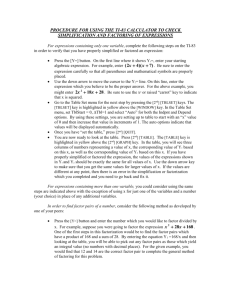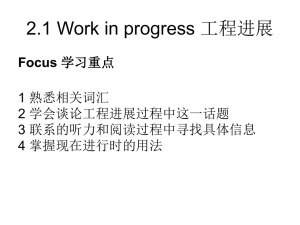Grade 6 Mathematics Module 4, Topic D, Overview
advertisement

New York State Common Core 6 x Mathematics Curriculum GRADE GRADE 6 • MODULE 4 Topic D Expanding, Factoring, and Distributing Expressions 6.EE.A.2a, 6.EE.A.2b, 6.EE.A.3, 6.EE.A.4 Focus Standards: Instructional Days: 6.EE.A.2 Write, read, and evaluate expressions in which letters stand for numbers. a. Write expressions that record operations with numbers and with letters standing for numbers. For example, express the calculation “Subtract 𝑦 from 5” as 5 − 𝑦. b. Identify parts of an expression using mathematical terms (sum, term, product, factor, quotient, coefficient); view one or more parts of an expression as a single entity. For example, describe the expression 2(8 + 7) as a product of two factors; view (8 + 7) as both a single entity and a sum of two terms. 6.EE.A.3 Apply the properties of operations to generate equivalent expressions. For example, apply the distributive property to the expression 3(2 + 𝑥) to produce the equivalent expression 6 + 3𝑥; apply the distributive property to the expression 24𝑥 + 18𝑦 to produce the equivalent expression 6(4𝑥 + 3𝑦); apply properties of operations to 𝑦 + 𝑦 + 𝑦 to produce the equivalent expression 3𝑦. 6.EE.A.4 Identify when two expressions are equivalent (i.e., when the two expressions name the same number regardless of which value is substituted into them). For example, the expressions 𝑦 + 𝑦 + 𝑦 and 3𝑦 are equivalent because they name the same number regardless of which number 𝑦 stands for. 6 Lesson 9: Writing Addition and Subtraction Expressions (P)1 Lesson 10: Writing and Expanding Multiplication Expressions (P) Lesson 11: Factoring Expressions (P) Lesson 12: Distributing Expressions (P) Lessons 13–14: Writing Division Expressions (P, P) 1Lesson Structure Key: P-Problem Set Lesson, M-Modeling Cycle Lesson, E-Exploration Lesson, S-Socratic Lesson Topic D: Expanding, Factoring, and Distributing Expressions This work is derived from Eureka Math ™ and licensed by Great Minds. ©2015 Great Minds. eureka-math.org This file derived from G6-M4-TE-1.3.0-09.2015 97 This work is licensed under a Creative Commons Attribution-NonCommercial-ShareAlike 3.0 Unported License. Topic D NYS COMMON CORE MATHEMATICS CURRICULUM 6•4 In Topic D, students formally utilize their understanding of expressions in order to expand, factor, and distribute. In Lesson 9, students write expressions that record addition and subtraction operations with numbers through the use of models. With a bar diagram, students understand that any number 𝑎 plus any number 𝑏 is the same as adding the numbers 𝑏 + 𝑎. Students also use bar diagrams to differentiate between the mathematical terms subtract and subtract from. For instance, when subtracting 𝑏 from 𝑎, they know they must first represent 𝑎 in order to take away 𝑏, leading to an understanding that the expression must be written 𝑎 − 𝑏. This concept deters students from writing the incorrect expression 𝑏 − 𝑎, which is a common misconception because the number 𝑏 is heard first in the expression “subtract 𝑏 from 𝑎.” Students continue to write expressions by combining operations with the use of parentheses. In Lesson 10, students identify parts of an expression using mathematical terms for multiplication. They view one or more parts of an expression as a single entity. They determine that through the use of models, when 𝑎 is represented 6 times, the expression is written as one entity: 6 × 𝑎, 6 ∙ 𝑎, or 6𝑎. In Lesson 11, students bring with them their previous knowledge of GCF and the distributive property from Module 2 to model and write expressions using the distributive property. They move from a factored form to an expanded form of an expression, while in Lesson 12, they move from an expanded form to a factored form. In Lesson 11, students are capable of moving from the expression 2𝑎 + 2𝑏 to 𝑎 + 𝑏 written twice as (𝑎 + 𝑏) + (𝑎 + 𝑏) and conclude that 2𝑎 + 2𝑏 = 2(𝑎 + 𝑏). Conversely, students determine in Lesson 12 that (𝑎 + 𝑏) + (𝑎 + 𝑏) = 2𝑎 + 2𝑏 through the following model: Finally, in Lessons 13 and 14, students write division expressions in two forms: dividend ÷ divisor and dividend divisor , noting the relationship between the two. They determine from the model below that 1 ÷ 2 is the 1 same as . They make an intuitive connection to expressions with letters and also determine that 𝑎 ÷ 2 is the 2 𝑎 same as . 2 1 2 Topic D: 𝑎 2 Expanding, Factoring, and Distributing Expressions This work is derived from Eureka Math ™ and licensed by Great Minds. ©2015 Great Minds. eureka-math.org This file derived from G6-M4-TE-1.3.0-09.2015 98 This work is licensed under a Creative Commons Attribution-NonCommercial-ShareAlike 3.0 Unported License.








